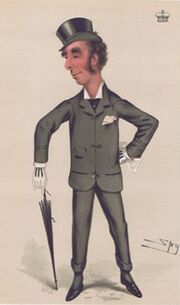
A caricature of John Douglas, Marquess of Queensberry, the caption reads "A good light weight"
The Marquess of Queensberry rules is a code of generally accepted rules in the sport of boxing. They were named so because John Douglas, 9th Marquess of Queensberry publicly endorsed the code,[1] although they were written by a sportsman named John Graham Chambers. The code of rules on which modern boxing is based, the Queensberry rules were the first to mention gloves in boxing.[2] The Queensberry rules are intended for use in both professional and amateur boxing matches, thus separating it from the less popular American Fair Play Rules, which were strictly intended for amateur matches. In popular culture the term is sometimes used to refer to a sense of sportsmanship and fair play.
History[]
The boxing code was written by John Graham Chambers a Welshman, and drafted in London in 1865, before being published in 1867 as "the Queensberry rules for the sport of boxing".[3][4] This code of rules superseded the Revised London Prize Ring rules (1853), which had themselves replaced the original London Prize Ring rules (1743) of Jack Broughton. This version persuaded boxers that "you must not fight simply to win; no holds barred is not the way; you must win by the rules" (17, sect. 5, pt. 1).
One early prize fighter who fought under Marquess of Queensberry rules was Jem Mace, who won the English heavyweight title under these rules in 1861. In 1889, the Queensberry rules came into use in the United States and Canada.[5]
Rules[]
- To be a fair stand-up boxing match in a 24-foot ring, or as near that size as practicable.
- No wrestling or hugging (clinching) allowed.
- The rounds to be of three minutes duration, and one minute's time between rounds.
- If either man falls through weakness or otherwise, he must get up unassisted, 10 seconds to be allowed him to do so, the other man meanwhile to return to his corner, and when the fallen man is on his legs the round is to be resumed and continued until the three minutes have expired. If one man fails to come to the scratch in the 10 seconds allowed, it shall be in the power of the referee to give his award in favour of the other man.
- A man hanging on the ropes in a helpless state, with his toes off the ground, shall be considered down.
- No seconds or any other person to be allowed in the ring during the rounds.
- Should the contest be stopped by any unavoidable interference, the referee to name the time and place as soon as possible for finishing the contest; so that the match must be won and lost, unless the backers of both men agree to draw the stakes.
- The gloves to be fair-sized boxing gloves of the best quality and new.
- Should a glove burst, or come off, it must be replaced to the referee's satisfaction.
- A man on one knee is considered down and if struck is entitled to the stakes.
- That no shoes or boots with spikes or sprigs be allowed. [6]
- The contest in all other respects to be governed by revised London Prize Ring Rules.
References[]
- ↑ Harris, Brian (2008) Intolerance: divided societies on trial p.182. Wildy, Simmonds & Hill Publishing, 2008
- ↑ Eric Dunning Sport matters: sociological studies of sport, violence, and civilization Routledge, 1999
- ↑ Queensberry Rules The Oxford Dictionary of Phrase and Fable
- ↑ William Joseph Baker (1998) Sports in the Western world Retrieved 2010-12-10
- ↑ Black Belt Oct 1999 Retrieved 2010-12-10
- ↑ Lawyers' reports annotated, Book 24